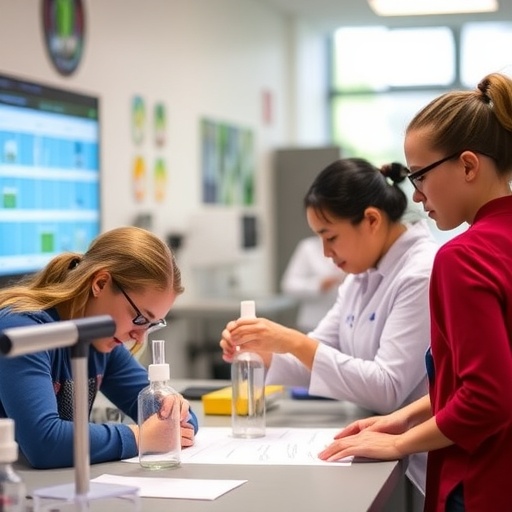In recent years, the landscape of education has witnessed a dramatic shift towards more innovative and engaging learning methods. One such method that has gained traction is the Science, Technology, Society, and Environment (STSE) model. This model is gaining recognition as an effective framework for enhancing students’ scientific competencies. According to a groundbreaking study conducted by Nguyen, Cao, and Tran in 2025, the STSE model is not just a theory but a practical approach that schools can adopt to prepare students for the complexities of the modern world.
At the core of the STSE model is the integration of science education with real-world applications. This approach encourages students to explore the connections between scientific principles and societal issues, fostering a deeper understanding of both. By positioning students as active learners, the STSE model promotes critical thinking and problem-solving skills, essential attributes in today’s fast-paced, technology-driven society. The active learning intervention outlined in the study demonstrates how engaging students in practical, hands-on experiences can transform their relationship with science.
The researchers implemented various active learning techniques within the STSE framework, focusing on making the learning process not only informative but also experiential. Students participated in projects that required them to investigate local environmental issues, demonstrating how scientific inquiry can lead to tangible community benefits. Through this experiential learning, students developed a sense of agency, learning that their scientific knowledge could be directly applied to solve real-life problems.
In their study, Nguyen and colleagues focused on a cohort of high school students. The results were striking. Students who participated in the STSE model reported increased interest in science subjects, with many expressing a newfound love for experimentation and exploration. This was particularly evident in students who had previously struggled with traditional teaching methods, revealing the STSE model’s potential as an inclusive educational approach that caters to diverse learning styles.
The findings highlight a critical gap in traditional education systems, where rote memorization often takes precedence over practical understanding. The STSE model addresses this by emphasizing natural curiosity and fostering an environment where students feel free to ask questions and seek solutions. By creating a culture of inquiry, educators can ignite students’ passion for learning, encouraging them to pursue STEM fields in higher education and careers.
Moreover, the researchers found that students developed not only scientific competencies but also valuable soft skills. Teamwork, communication, and leadership emerged as key competencies that students honed throughout their participation in the active learning interventions. Collaborative projects encouraged students to work together, share ideas, and tackle challenges collectively, preparing them for future workplace environments that increasingly value team-based approaches.
The implications of this study are vast. As educators and policymakers become more aware of the limitations within conventional teaching methodologies, evidence-based practices like the STSE model will gain prominence. Schools may begin to rethink their curricula, reallocating resources to support innovative teaching methods that better prepare students for the challenges they will face as future citizens and professionals.
In a world increasingly shaped by technological advancements, the need for scientifically literate individuals is paramount. The STSE model stands out because it not only equips students with scientific knowledge but also instills a sense of responsibility towards society and the environment. This holistic approach is crucial in producing informed citizens who can engage in meaningful dialogues about global issues such as climate change, social inequities, and technological ethics.
Looking to the future, implementing the STSE model widely could significantly influence educational policies at regional and national levels. As academic institutions begin to recognize the effectiveness of active learning strategies, funding and support for such initiatives could increase. Educators who embrace this paradigm shift will be instrumental in shaping a generation of learners who are not just consumers of information but are active participants in the scientific community and their own futures.
The study by Nguyen and colleagues serves as a call to action for educators everywhere. By fostering a culture grounded in inquiry, critical thinking, and real-world relevance, we can cultivate an educational environment where scientific competence thrives. It presents a vision of education that transcends traditional confines, advocating for a transformative approach that genuinely prepares students for the future.
In conclusion, the STSE model represents a beacon of hope for educators worldwide. As we continue to recognize the importance of scientific literacy and active engagement in learning, this framework can redefine the role of science education in shaping informed, responsible citizens. The journey toward an educational revolution has begun, one where students are not just learning about science in isolation but are engaged in the broader conversations that impact our society. This model could pave the way for a future where education is dynamic, inclusive, and profoundly impactful.
The findings and methodologies explored in Nguyen, Cao, and Tran’s study not only enrich the academic discourse but also provide a practical roadmap for educators seeking to implement active learning in their classrooms. As education evolves, the integration of models like STSE will be paramount in addressing the diverse needs of students and preparing them for an interconnected world.
Through the efforts of innovative educators and researchers, we stand at the precipice of a revolution in how we approach science education. The evidence of the STSE model’s effectiveness serves as a reminder that the best way to cultivate a passion for learning is through active engagement and real-world relevance. It is a call to reimagine the educational landscape, ensuring that students are prepared not just with knowledge, but with the skills and mindset to navigate the complexities that lie ahead.
Subject of Research: Enhancing students’ scientific competence through the STSE model.
Article Title: Developing students’ scientific competence through the STSE model: an active learning intervention.
Article References:
Nguyen, Q.L., Cao, T.K., Tran, Q.H. et al. Developing students’ scientific competence through the STSE model: an active learning intervention.
Discov Educ 4, 363 (2025). https://doi.org/10.1007/s44217-025-00766-2
Image Credits: AI Generated
DOI:
Keywords: Science Education, STSE Model, Active Learning, Scientific Competence, Educational Reform.




